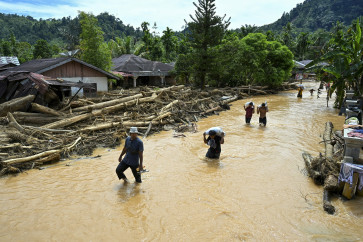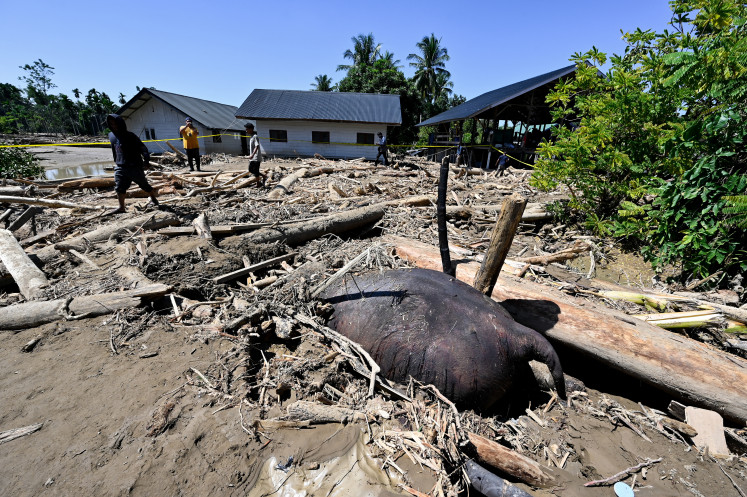Popular Reads
Top Results
Can't find what you're looking for?
View all search resultsPopular Reads
Top Results
Can't find what you're looking for?
View all search resultsBamboo Rangers - spearhead sustainable management
Bamboo for life: A man cuts down a bamboo tree during the training program
Change text size
Gift Premium Articles
to Anyone
![Bamboo for life: A man cuts down a bamboo tree during the training program. (Courtesy of Emil Fischer. )" height="768" width="512" border="0"><span class="caption"><strong></strong></span></span></p><p><span class="inline inline-center"><span class="caption"><strong>Bamboo for life: </strong>A man cuts down a bamboo tree during the training program. (Courtesy of Emil Fischer. )</span></span></p><p>Bamboo, a tall grass with the appearance of a tree, may not be under threat of extinction, but the high demand for this valuable commodity for construction and furniture in Bali has raised concerns, prompting bamboo activists to teach farmers to manage bamboo forests wisely.</p><p>I Nyoman Conto took 25 farmers and bamboo activists to his bamboo field in Bubungklambu, Bangli regency, Bali, to gather around clumps of giant bamboo, a species locally known as petung.<br><br>âWe call it petung hijau, jali, gembe, apus and by other names as this bamboo has many varieties,â said Conto, a father-of-six who initiated the Dwi Panca Kerti Cooperative in the hamlet in 2009. The cooperative was the first organization to sell bamboo when the locals saw an increase in demand for the products in 2012. <br><br>The farmers and activists took part in field training on sustainable bamboo forest management to become bamboo rangers. The training was conducted in cooperation with the Environment and Forestry Ministry and the International Tropical Timber Organization (ITTO).<br><br>âA ranger here means an official responsible for managing and protecting an area of forestry,â said Desy Ekawati, project coordinator of the Indonesian Bamboo Project. <br><br>The training is aimed at enhancing bamboo farmersâ capabilities in managing bamboo clumps in a sustainable way and improving the management of the bamboo, she said.</p><p><span class="inline inline-center"><img class="image image-img_assist_custom-512x338 " src="http://202.158.21.182/files/images2/P22-B.Bamboo.img_assist_custom-512x338.jpg" alt="Sharing: A group of participants present their work during the training program. (Photo by Lily G. Nababan)" title="Sharing: A group of participants present their work during the training program. (Photo by Lily G. Nababan)" height="338" width="510" border="0"><span class="caption"><strong></strong></span></span></p><p><span class="inline inline-center"><span class="caption"><strong>Sharing: </strong>A group of participants present their work during the training program. (Photo by Lily G. Nababan)</span></span></p><p>The term âbamboo rangersâ was first coined by Arief Rabik, an activist, entrepreneur and owner of a Bali-based bamboo lamination factory, Indo Bamboo. <br><br>However, the lack of consistent bamboo supply and quality has forced Arief to source the material from Flores Island to get the right quality for his strand-woven bamboo, which is put under 4800-ton pressure to strengthen it like wood. <br><br>âIn Bali, itâs hard to get 150 stems of petung of the necessary quality daily for six days a week,â said Arief, who founded the Bambu Lestari Foundation and has written a book titled Menuju Perhutanan Bambu yang Tangguh (Toward perpetual bamboo forests).<br><br>Baliâs bamboo demand remains high. Industry Ministry data in 2010 showed Bali consumed 2 million bamboo stems for ceremonies and furniture. <br><br>âSadly, most farmers are engaged in bamboo felling when they need it but they leave it to decay when itâs not in demand,â Desy said.<br><br>In fact, Bangli has 6,500 hectares of bamboo with the potential to increase to 8,000 ha. Desy said there would be a significant increase in bamboo demand with the moratorium on the felling of Indonesian forest wood and advanced nationsâ green movements.<br><br>Therefore, it has become more than just a matter of maintaining the existing forests and planting new crops in order to enable local people to promote bamboo cultivation. <br><br>Pande Ketut Diah Kencana, an agricultural expert from Udayana University, describes bamboo as âgreen goldâ. If appropriately managed, plants can produce for more than 100 years. To further develop bamboo there should be communities, as symbolized by bamboo clumps, she says. <br><br>The role of rangers is thus to watch over bamboo quality and determine the right harvest time to secure high-quality bamboo, while at the same time ensuring the proper growth of young bamboo clumps.<br><br>Diah, a lecturer in agricultural technology for 30 years, stressed the place of the bamboo industry in promoting the peopleâs economy. <br><br>âThere should be cooperatives with bamboo farmers as members in the upstream, with home industries producing handicrafts, culinary specialties [bamboo shoots] and others in the downstream,â she said.<br><br>Diah, a pioneer in the cultivation of tabah bamboo, has fostered around 1,100 farmers in Pupuan district, Tabanan regency, where she planted 1,200 bamboo trees 2006 on land she bought. In 2014, her cooperative harvested 12,000 bamboo stems in a season. <br><br>Diah emphasized the importance of farmersâ industrial processes and market access. <br><br>âTo maximize their bamboo planting and output potential, the government has a vital role in the upstream, for instance in providing cheap loans for cooperatives,â she said.<br><br>She said the best quality of running bamboo is found in China but the worldâs best quality of clumping bamboo is in Indonesia.</p><p><span class="inline inline-center"><img class="image image-img_assist_custom-510x384 " src="http://202.158.21.182/files/images2/P22-C.Bamboo.img_assist_custom-510x384.jpg" alt="Crunchy meal: Bamboo shoots from a local bamboo cooperative led by Diah. (Courtesy of Pande Ketut Diah Kencana)" title="Crunchy meal: Bamboo shoots from a local bamboo cooperative led by Diah. (Courtesy of Pande Ketut Diah Kencana)](https://www.thejakartapost.com/files/images2/p22-A.Bamboo.jpg) Bamboo for life: A man cuts down a bamboo tree during the training program. (Courtesy of Emil Fischer. )" height="768" width="512" border="0">
Bamboo for life: A man cuts down a bamboo tree during the training program. (Courtesy of Emil Fischer. )" height="768" width="512" border="0">Bamboo for life: A man cuts down a bamboo tree during the training program. (Courtesy of Emil Fischer. )
Bamboo, a tall grass with the appearance of a tree, may not be under threat of extinction, but the high demand for this valuable commodity for construction and furniture in Bali has raised concerns, prompting bamboo activists to teach farmers to manage bamboo forests wisely.
I Nyoman Conto took 25 farmers and bamboo activists to his bamboo field in Bubungklambu, Bangli regency, Bali, to gather around clumps of giant bamboo, a species locally known as petung.
âWe call it petung hijau, jali, gembe, apus and by other names as this bamboo has many varieties,â said Conto, a father-of-six who initiated the Dwi Panca Kerti Cooperative in the hamlet in 2009. The cooperative was the first organization to sell bamboo when the locals saw an increase in demand for the products in 2012.
The farmers and activists took part in field training on sustainable bamboo forest management to become bamboo rangers. The training was conducted in cooperation with the Environment and Forestry Ministry and the International Tropical Timber Organization (ITTO).
âA ranger here means an official responsible for managing and protecting an area of forestry,â said Desy Ekawati, project coordinator of the Indonesian Bamboo Project.
The training is aimed at enhancing bamboo farmersâ capabilities in managing bamboo clumps in a sustainable way and improving the management of the bamboo, she said.

Sharing: A group of participants present their work during the training program. (Photo by Lily G. Nababan)
The term âbamboo rangersâ was first coined by Arief Rabik, an activist, entrepreneur and owner of a Bali-based bamboo lamination factory, Indo Bamboo.
However, the lack of consistent bamboo supply and quality has forced Arief to source the material from Flores Island to get the right quality for his strand-woven bamboo, which is put under 4800-ton pressure to strengthen it like wood.
âIn Bali, itâs hard to get 150 stems of petung of the necessary quality daily for six days a week,â said Arief, who founded the Bambu Lestari Foundation and has written a book titled Menuju Perhutanan Bambu yang Tangguh (Toward perpetual bamboo forests).
Baliâs bamboo demand remains high. Industry Ministry data in 2010 showed Bali consumed 2 million bamboo stems for ceremonies and furniture.
âSadly, most farmers are engaged in bamboo felling when they need it but they leave it to decay when itâs not in demand,â Desy said.
In fact, Bangli has 6,500 hectares of bamboo with the potential to increase to 8,000 ha. Desy said there would be a significant increase in bamboo demand with the moratorium on the felling of Indonesian forest wood and advanced nationsâ green movements.
Therefore, it has become more than just a matter of maintaining the existing forests and planting new crops in order to enable local people to promote bamboo cultivation.
Pande Ketut Diah Kencana, an agricultural expert from Udayana University, describes bamboo as âgreen goldâ. If appropriately managed, plants can produce for more than 100 years. To further develop bamboo there should be communities, as symbolized by bamboo clumps, she says.
The role of rangers is thus to watch over bamboo quality and determine the right harvest time to secure high-quality bamboo, while at the same time ensuring the proper growth of young bamboo clumps.
Diah, a lecturer in agricultural technology for 30 years, stressed the place of the bamboo industry in promoting the peopleâs economy.
âThere should be cooperatives with bamboo farmers as members in the upstream, with home industries producing handicrafts, culinary specialties [bamboo shoots] and others in the downstream,â she said.
Diah, a pioneer in the cultivation of tabah bamboo, has fostered around 1,100 farmers in Pupuan district, Tabanan regency, where she planted 1,200 bamboo trees 2006 on land she bought. In 2014, her cooperative harvested 12,000 bamboo stems in a season.
Diah emphasized the importance of farmersâ industrial processes and market access.
âTo maximize their bamboo planting and output potential, the government has a vital role in the upstream, for instance in providing cheap loans for cooperatives,â she said.
She said the best quality of running bamboo is found in China but the worldâs best quality of clumping bamboo is in Indonesia.
 <)
<)
Bamboo for life: A man cuts down a bamboo tree during the training program. (Courtesy of Emil Fischer. )
Bamboo, a tall grass with the appearance of a tree, may not be under threat of extinction, but the high demand for this valuable commodity for construction and furniture in Bali has raised concerns, prompting bamboo activists to teach farmers to manage bamboo forests wisely.
I Nyoman Conto took 25 farmers and bamboo activists to his bamboo field in Bubungklambu, Bangli regency, Bali, to gather around clumps of giant bamboo, a species locally known as petung.
'We call it petung hijau, jali, gembe, apus and by other names as this bamboo has many varieties,' said Conto, a father-of-six who initiated the Dwi Panca Kerti Cooperative in the hamlet in 2009. The cooperative was the first organization to sell bamboo when the locals saw an increase in demand for the products in 2012.
The farmers and activists took part in field training on sustainable bamboo forest management to become bamboo rangers. The training was conducted in cooperation with the Environment and Forestry Ministry and the International Tropical Timber Organization (ITTO).
'A ranger here means an official responsible for managing and protecting an area of forestry,' said Desy Ekawati, project coordinator of the Indonesian Bamboo Project.
The training is aimed at enhancing bamboo farmers' capabilities in managing bamboo clumps in a sustainable way and improving the management of the bamboo, she said.
Sharing: A group of participants present their work during the training program. (Photo by Lily G. Nababan)
The term 'bamboo rangers' was first coined by Arief Rabik, an activist, entrepreneur and owner of a Bali-based bamboo lamination factory, Indo Bamboo.
However, the lack of consistent bamboo supply and quality has forced Arief to source the material from Flores Island to get the right quality for his strand-woven bamboo, which is put under 4800-ton pressure to strengthen it like wood.
'In Bali, it's hard to get 150 stems of petung of the necessary quality daily for six days a week,' said Arief, who founded the Bambu Lestari Foundation and has written a book titled Menuju Perhutanan Bambu yang Tangguh (Toward perpetual bamboo forests).
Bali's bamboo demand remains high. Industry Ministry data in 2010 showed Bali consumed 2 million bamboo stems for ceremonies and furniture.
'Sadly, most farmers are engaged in bamboo felling when they need it but they leave it to decay when it's not in demand,' Desy said.
In fact, Bangli has 6,500 hectares of bamboo with the potential to increase to 8,000 ha. Desy said there would be a significant increase in bamboo demand with the moratorium on the felling of Indonesian forest wood and advanced nations' green movements.
Therefore, it has become more than just a matter of maintaining the existing forests and planting new crops in order to enable local people to promote bamboo cultivation.
Pande Ketut Diah Kencana, an agricultural expert from Udayana University, describes bamboo as 'green gold'. If appropriately managed, plants can produce for more than 100 years. To further develop bamboo there should be communities, as symbolized by bamboo clumps, she says.
The role of rangers is thus to watch over bamboo quality and determine the right harvest time to secure high-quality bamboo, while at the same time ensuring the proper growth of young bamboo clumps.
Diah, a lecturer in agricultural technology for 30 years, stressed the place of the bamboo industry in promoting the people's economy.
'There should be cooperatives with bamboo farmers as members in the upstream, with home industries producing handicrafts, culinary specialties [bamboo shoots] and others in the downstream,' she said.
Diah, a pioneer in the cultivation of tabah bamboo, has fostered around 1,100 farmers in Pupuan district, Tabanan regency, where she planted 1,200 bamboo trees 2006 on land she bought. In 2014, her cooperative harvested 12,000 bamboo stems in a season.
Diah emphasized the importance of farmers' industrial processes and market access.
'To maximize their bamboo planting and output potential, the government has a vital role in the upstream, for instance in providing cheap loans for cooperatives,' she said.
She said the best quality of running bamboo is found in China but the world's best quality of clumping bamboo is in Indonesia.
Crunchy meal: Bamboo shoots from a local bamboo cooperative led by Diah. (Courtesy of Pande Ketut Diah Kencana)
In anticipation of the Asian Economic Community, with an influx of products into Indonesia including bamboo in 2016, Diah set up a bamboo research and development center in her university in 2012 to guide bamboo industries.
Arief, a graduate of the Royal Melbourne Institute of Technology, linked the bamboo quality to the role of rangers. The practice of bamboo felling just to meet instant needs should be changed to sustainable felling, which requires rangers' control.
'Rangers with a prominent capability will become leaders of their peers,' said Arief, adding that in Ban village, Karang Asem, such training took six months.
Growing bamboo trees also helps improve the environment as they can absorb carbon dioxide effectively. In Paris at the 21st session of the Climate Change Conference to the Parties (COP 21), the Environmental Bamboo Foundation and the Indonesian Environment and Forestry Ministry presented a partnership to offer a bamboo forest-based community model to face climate change.
'The idea is to create 1,000 bamboo villages,' said Desy, who represented the partnership with Arief.
The communities in these villages will be responsible for bamboo planting, management and raw material processing for three types of bamboo industries, namely bamboo lamination for high-quality wood alternatives, bamboo textiles as a substitute for cotton, and bamboo pulp and paper to replace wood.










